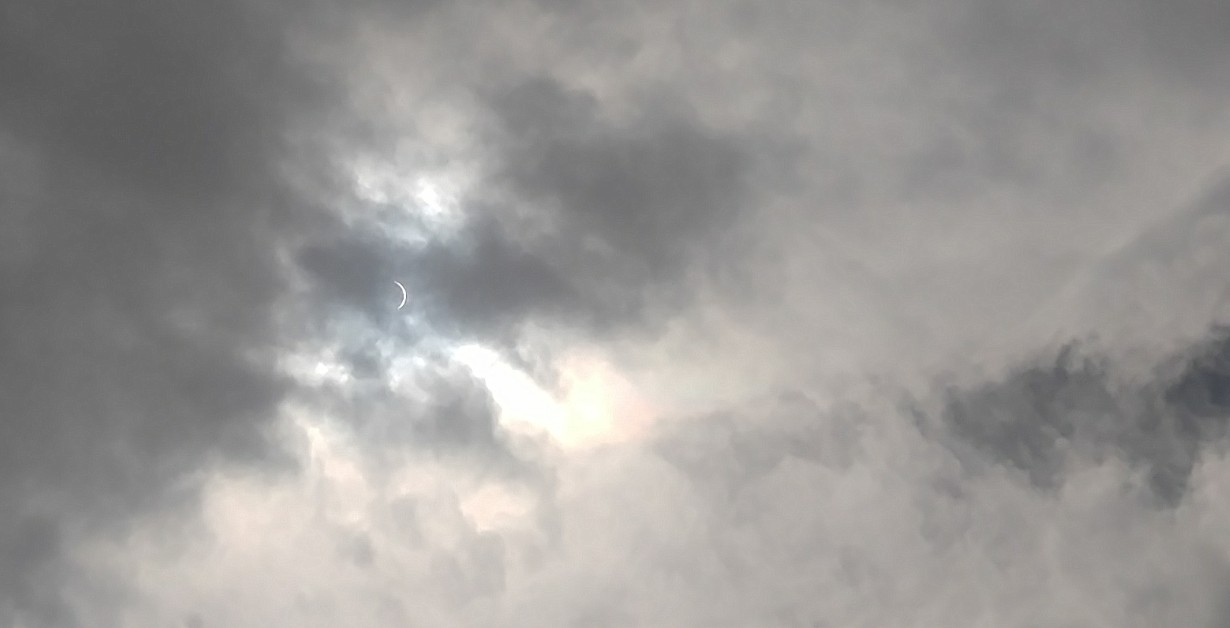| Observer: | Tom Campbell |
| Location: | Hiawatha, Kansas (Long: 95°29'W Lat: 39°50'N) |
| Telescope: | Meade AS80 3" refractor |
On Saturday, August 19, my wife, nephew and I traveled to Kansas to see the total eclipse. We flew to Tulsa, Oklahoma and then rented a large SUV (dubbed The Eclipsemobile) to drive on into Iola, Kansas where my parents and brother live. We spent the night in Iola and then the six of us journeyed northward to Lawrence on Sunday. This would put us only about 90 minutes away from the eclipse location we had reserved near Hiawatha, Kansas.
Monday morning's drive to the eclipse site was uneventful. Traffic was light all the way, which surprised me a little. Perhaps everyone arrived early and us last-minute travelers got lucky.
The morning was partly cloudy, with a lot of high cirrus clouds and a few cumulus clouds. If the sky remained like this, chances were good we'd get to see the eclipse. However, the farther north we went, the worse the skies became. By the time we had arrived at our destination, only small sucker holes were visible in a gray, overcast sky.
I wasn't about to travel 750 miles just to call it quits, so I set up anyway. There were about 50 of us altogether at the farm. About half an hour before the eclipse, it began sprinkling off and on. Everyone scrambled to put covers over their telescopes. I didn't have a telescope cover, but grabbed a spare shirt my brother had brought and used it.
A few of the folks gave up and left to try to find clearer skies. We looked at the map and nothing really looked any better that was within driving distance, so we decided to stay and see what happened. Amazingly, even as it was still sprinkling, the sun started shining through a small hole in the clouds. I ran out of the barn and back to my telescope, taking off the shirt and aiming the scope at the sun. A little rain shouldn't hurt - I've had dew on my telescope that was worse than this. I soon was rewarded with a nice view of the eclipse in the sun funnel, but it was a bit surreal to be wiping raindrops off the projector screen while it was showing me the eclipsing sun.
We started getting excited, thinking that the sucker hole would last long enough for us to see totality. But alas, it wasn't meant to be. About 5-10 minutes before totality, the hole closed back up again. Forget the need for solar filters and eclipse glasses. We were even having difficulty telling where the sun was with our naked eye.
Everyone had their telescopes and cameras at the ready, just in case the sun decided to come out again. An app on my phone called out times. "One minute to totality." Bleh! Nothing was visible, except for noticing the ever-darkening sky.
In spite of not seeing totality, we did notice some of its effects on the environment. For one, the gusting wind had died down almost completely. The dark twilight was deepening fast and the birds stopped chirping. Many of us saw the shadow of the moon rush across the clouds as totality hit, putting us in skies too dark to read by. And then we saw the 360 degree sunset shining through holes in the clouds along the horizon. In every direction, it looked like the sun was setting, creating a nice wide stripe of orange next to the dark blue and gray sky. No doubt about it: even without seeing the sun go dark, this experience was worth the trip.
Then, all too soon, the dark shadow raced across the sky again and we knew totality was over. The orange bands had disappeared, the birds began singing again, and the wind started picking back up. But looking up towards the sun, we were greeted with another sight: the sun was peeking through again!

The sun was such a narrow crescent and we were all looking at it with our naked eyes, thanks to the cloud cover. It seemed like I was standing on another world. I heard someone cheering. I really don't know if it was myself or someone else. It could have been me. I was mesmerized.
The clouds seemed to be opening up a bit more, and soon everyone was putting on their eclipse glasses and aiming their gear at the sun again. Although the clouds remained, they were a bit more transparent and we were able to watch most of the rest of the eclipse as the moon slowly slid away from the sun again.
Going back home afterwards, traffic got heavy quickly and the three hour drive back to Iola took us six hours. During the long trip, we all reflected on what we had seen and despite the cloud cover, rain, and missing out on totality, we agreed that it was worth it all and we'd do it again in a heartbeat.
My Dad is in his eighties and has worsening eyesight. He tried the eclipse glasses and the filtered binoculars and wasn't able to see anything at all. But he could easily see the eclipse through my sun funnel, so I'm very glad I brought it. We were able to see the sunspots on the projected screen, but the photographs didn't record them very well. I knew that with the sun funnel in place, I wouldn't be getting a lot of fine details of the sun, but having my Dad be able to see the eclipse was the main thing to me.